What greens can be grown?
Microgreens are young shoots of plants with the highest content of nutrients. They are used in salads, first and second courses, smoothies and bowls.
Advantages of microgreens:
- Does not take up much space. Unlike regular basil or dill.
- Can be grown without substrate and fertilizers. The process is cleaner, simpler, more hygienic.
- Quick result. You don’t have to wait several weeks — it usually takes several days (maximum 10) from planting to harvest. On average, microgreens grow faster — 6-7 days.
- Easy to care for. Requires only watering: no pest and disease treatment — they simply do not have time to overcome the shoots.
- Incredibly useful. A serving of sprouts contains a huge amount of proteins, minerals, and vitamins for your body.
Important! Do not confuse sprouts and microgreens. In the first case, they only wait for the sprouts to “hatch” from the grain, and eat the sprouts completely. Microgreens are grown until the first 2 leaves appear, and only the stem and leaves are eaten.
In fact, you can grow microgreens from almost any seeds – from lettuce and cabbage to vegetables. But the most delicious and healthy for consumption are considered to be:
Important! You cannot eat the following as microgreens: beans, potatoes, tomatoes, eggplants, peppers. Young sprouts contain substances that are dangerous to humans.

How to choose the right seeds?
Growing microgreens at home starts with seeds: the success of the entire operation depends on the quality of the raw materials.
It is not recommended to use seeds from garden stores intended for growing full-fledged crops. Firstly, there are very few of them in the package. Secondly, you can’t call the seeds useful – so that they are stored longer and behave better after planting, they are treated with various preparations before packaging.
Look for planting material specifically for growing microgreens: it is sold in large packages (50-500 g), and is not treated with anything before packaging. Usually comes to stores after long tests and selections: it means it will germinate effectively and grow evenly.
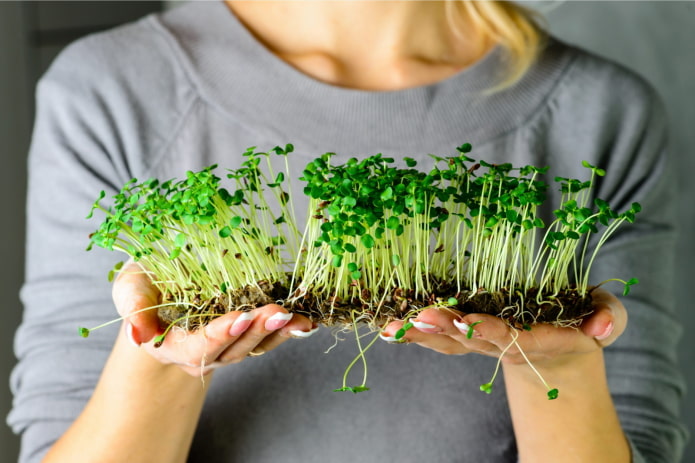
Methods of growing at home
There are many working methods for growing microgreens: from simply soaking in water and maintaining high humidity to planting in ordinary soil. Which one is right for you – decide for yourself.
Soil
The most common option for sowing seeds is directly into the ground. Almost any soil will do for growing microgreens: from regular garden soil (pre-treat it for pests) to store-bought soil – it is better to take bags for indoor plants for home use (except for a lean mixture for cacti, bark for orchids).
Step-by-step instructions:
- Take any suitable tray (plastic, paper, foam or glass are best for germination).
- Fill the bottom with a small amount of soil (an even layer of 0.5 cm will be enough).
- Spray the soil with water from a spray bottle.
- Spread the seeds evenly in one layer, leaving no empty areas. Lightly tamp (no need to cover with soil!).
- Cover the container with a lid, film or wrap it in a bag. Place in a warm, bright (but not too sunny) place.
Important! Before use, containers undergo special treatment: they should be washed and wiped with hydrogen peroxide or soaked in a solution of potassium permanganate. This reduces the chances of fungus to zero.
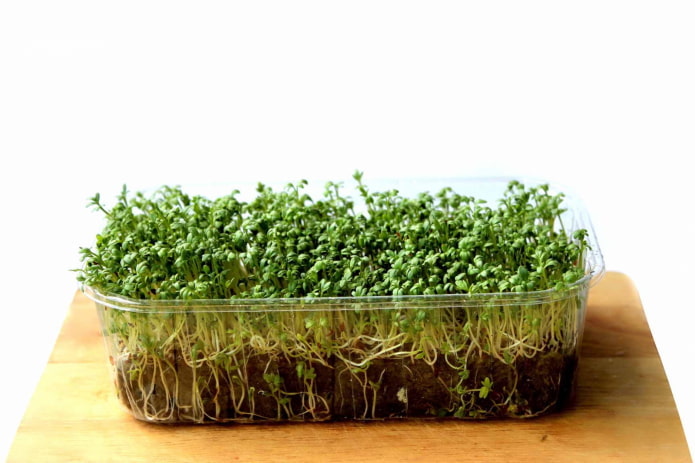
Now all that remains is to check the container: open it 1-2 times a day for ventilation (prevents mold). Add water directly to the roots as needed.
You can use the information on the packaging to determine how long it takes for the crop to ripen. But it is safer to cut the greens when the first cotyledon leaves appear – at this moment the small plants are the most delicious and useful.
Advice! Choose trays with walls of 3-7 cm – the sides will hold the growing microgreens together.
Paper
Soil is the most understandable, but the dirtiest way of growing. To make the process cleaner, it can be replaced with ordinary paper.
Soft paper napkins or toilet paper are best. Choose white or gray – without dyes, flavors.
The process of planting microgreens on toilet paper is not much different from the one described above:
- wash the dishes,
- lay out napkins, having previously moistened the “soil”,
- scatter the seeds,
- cover with film or a lid.
Micro-vegetables germinate no worse than in the ground. See for yourself:
Gauze
The third convenient way to plant microgreens is simple gauze. In the mesh material, the roots are simultaneously moistened and breathe, which eliminates their rotting. Planting in gauze should be done in the same way as in paper:
- Take a suitable food tray (transparent or solid), treat it with potassium permanganate.
- Lay gauze on the bottom, soak it in water.
- Scatter the seeds.
- Cover, leaving in a place with suitable light and temperature.
Be sure to make holes in the lid or ventilate the tray a couple of times a day so that the sown seedlings do not get moldy. Check the humidity once a day — the gauze should not dry out.
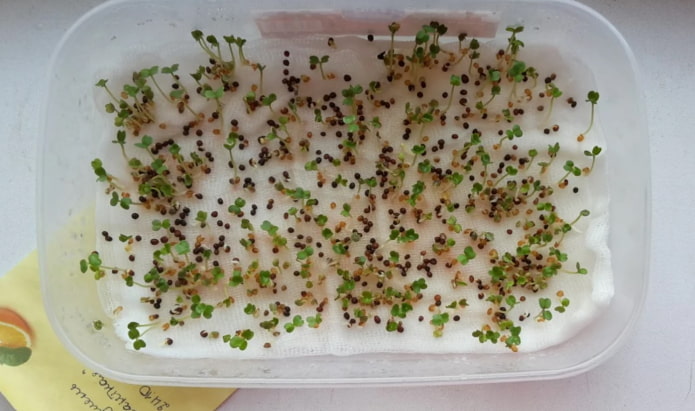
Cotton pads
When none of the above is in stock, you can grow microgreens on cotton wool. The principle is the same: cotton pads or layers act as a base that gives the green seedlings the main thing — life-giving moisture.
The method is the same: cover the bottom of the container with disks, moisten, pour in the seeds of the selected variety, then cover with a bag or a suitable lid. Spray and ventilate — as needed.
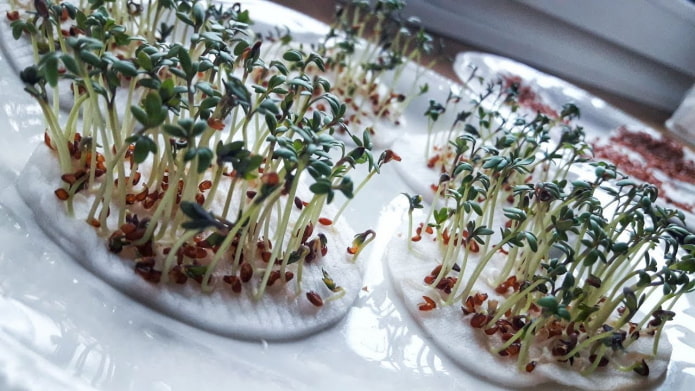
Jar
This method is well known to those who once germinated seeds. And in fact, it is best suited for sprouting, but if you are going to eat microgreens with roots and seeds, try growing it in a jar.
You will need:
- 1 liter jar;
- gauze or fine mesh;
- elastic band or rope.
Process stages:
- Pour 3-4 teaspoons of seeds into a liter jar, pour in 0.5 liters of settled water at room temperature. Leave overnight in the open to soak.
- The next day, put gauze or mesh on the neck, fix with an elastic band. Drain the liquid, rinse the contents under running water, drain again. Distribute the seeds evenly along the walls and bottom. We install it with the neck down at an angle of 30 degrees so that excess water drains.
- During the following days, we wash it every 5-6 hours. In between, we leave it on the window with sufficient lighting (at an angle with the neck down).
We let the sprouted greens grow properly and release their first leaves – most vegetables or green crops can be eaten on the 6-7th day. After the leaves appear, the contents of the jar are washed again and thrown into a colander, allowing excess water to drain freely.
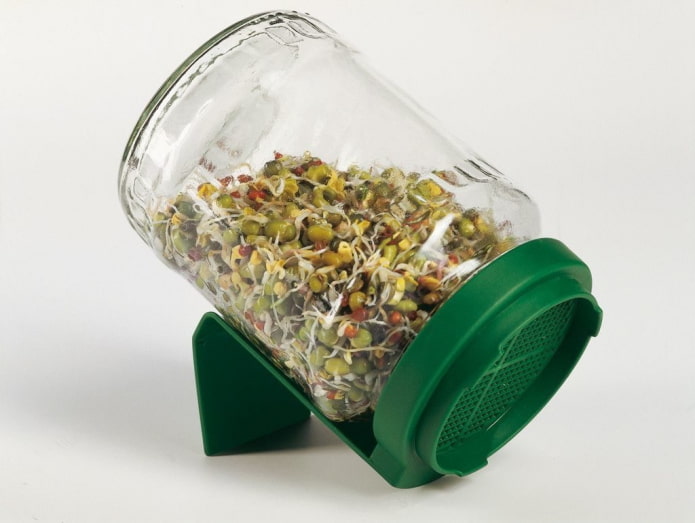
The photo shows a special jar with a lid for germination
Sprouter
You can try to grow microgreens with your own hands using any of the methods described above. But if you want to have sprouts rich in vitamins on your plate all year round, and not spend a lot of effort on cultivation, use special equipment.
A reliable option, with which problems are almost impossible, is a multi-layer tray. There is a compartment for water at the bottom, a mesh in the middle, and a lid on top. The lid maintains a microclimate, and excess moisture evaporates through special ventilation holes – they also provide an influx of fresh air. All you have to do is add water every few days and monitor the growth. When the first two leaves appear, it’s time to cut off the finished healthy food supplement.
In addition to the above option, there are also kits with special jute mats – germination occurs in the same way as in paper or cotton wool.
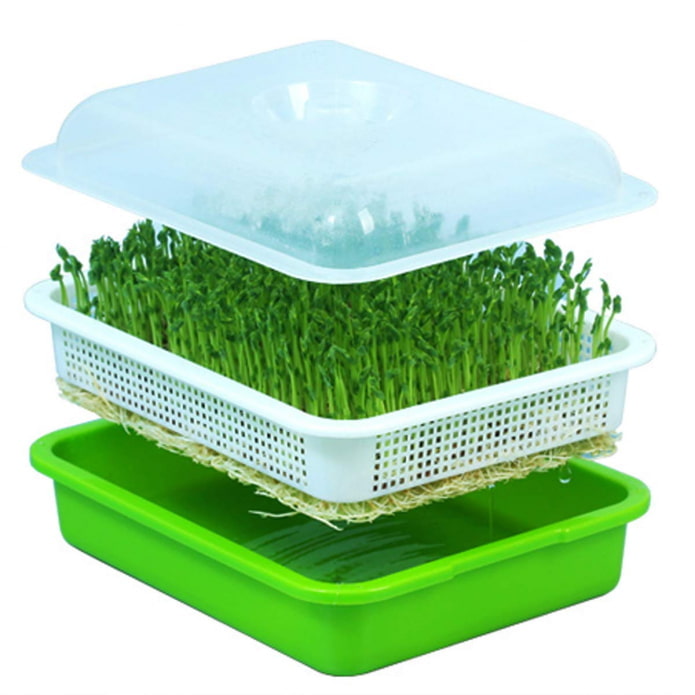
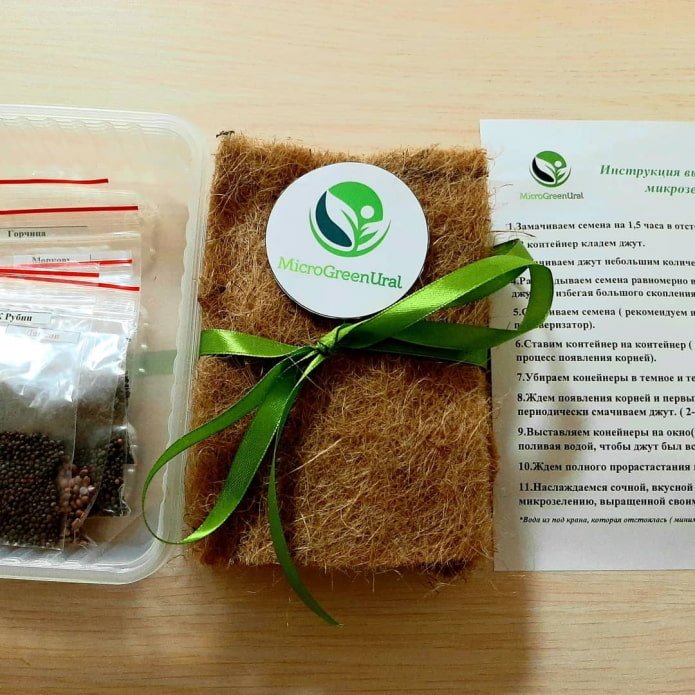
How to care for them?
Microgreens require minimal care, which consists of two main tasks: supplying fresh air and adding water.
Fill or overdry the base on which the seeds grow, do not: watering should be moderate, but regular. If you are afraid of overwatering, it is better to use a spray bottle and simply spray the seedlings.
It is necessary to ventilate the trays with lids without ventilation holes every day – several times. Make sure that cold air or a draft does not blow through the delicate microgreens.
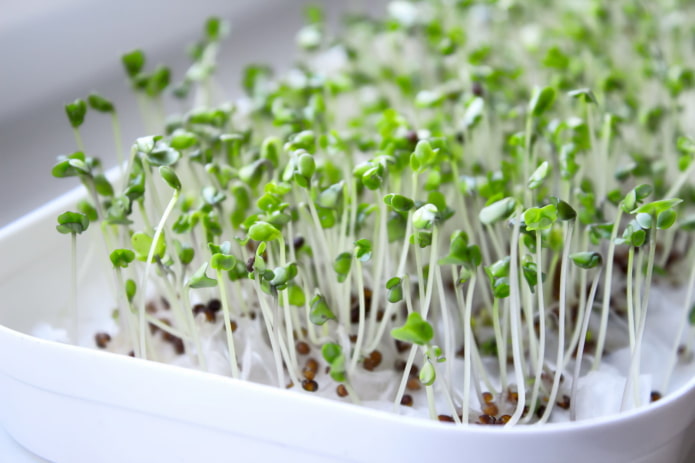
Microgreen is consumed in its pure form, added to various salads, cocktails – it is an excellent source of real vitamins, minerals, vegetable proteins, and it is easy to grow it yourself. So why not try it yourself.
Now reading:
- The best carpet for home: advantages and disadvantages, 33 interior photos
- Chester sofa: 35 photos in the interior, options for materials and colors
- Ceiling design: more than 90 photos and ideas for styles and spaces.
- Tips for Updating Your Kitchen on a Budget Without Renovating
- Shelves and bookcases: more than 60 photos, current design solutions